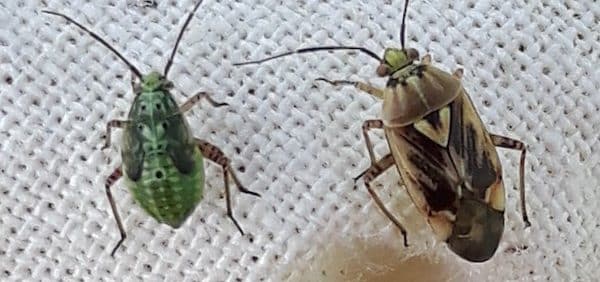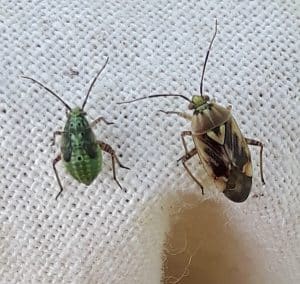Bertha armyworm. Most areas of the Prairies are low to moderate risk, according to moth counts. Even if an area is low risk according to provincial risk maps, local hot spots can flare up – which is why each farm should make its own assessment on a field by field basis. How to scout.
–Prairie Pest Monitoring Network reports: Model simulations for August 3, 2020, indicate that bertha armyworm development varies across the Prairies. For example, populations near Winnipeg are predicted to be developing to pupae, with reductions in larvae, while populations near Grande Prairie are expected to be primarily in the larval stage. PPMN has graphs and more details.
Lygus bugs. Some farms are seeing more lygus than usual, but most counts are still below thresholds. James Tansey, entomologist for the Saskatchewan Ministry of Agriculture, says higher levels of lygus have been reported in mature canola near Moose Jaw, but the field is “likely too far along to be damaged”. Once pods become leathery and seeds start to mature, lygus mouth parts can’t penetrate them. How to scout, when to scout and thresholds. Lygus big update from Prairie Pest Monitoring Network report.
Grasshoppers. Manitoba Agriculture reports some grasshopper feeding on canola pods near the Red River Valley. John Gavloski, entomologist for Manitoba Agriculture and Resource Development, says: “Grasshoppers are moving into some canola as other crops mature or are cut. Some insecticide applications have occurred, but this is not widespread. Sometimes there is an edge effect when they are moving in from other crops, resulting in only a portion of the field needing to be treated.”
The nominal threshold for grasshoppers in canola is eight to 12 per square metre. The higher end of that range may be more appropriate in a typical canola crop as, given a choice, most grasshopper species prefer grass and cereals to canola. Grasshoppers are often at higher numbers at field margins, making a targeted spray possible. But they will migrate across fields, so scout to see where that ‘margin’ ends. How to scout.
–Prairie Pest Monitoring Network reports: As of August 3, 2020, the grasshopper model estimates that prairie grasshopper populations are primarily adults. Based on model simulations, development has been slowest across central and northern regions of Alberta. Oviposition has begun across southern Manitoba and southeastern Saskatchewan. See the full report.
Diamondback moth larvae. Canola Watch reported a couple weeks ago on hot spots in Saskatchewan’s R.M. 10 and eastern Manitoba. John Gavloski says levels in Manitoba seem to have dropped and there are no recent reports of economic levels of diamondback moth.
The threshold for flowering or podded plants is 200 to 300 diamondback moth larvae per square metre (20 to 30 per square foot). For easier counting, pull up all plants from one square foot and beat them on flat surface, such as a sheet or truck hood, to dislodge them. The Canola Encyclopedia has more on diamondback moth larvae identification, scouting and thresholds.
–Prairie Pest Monitoring Network reports: Model runs (as of August 3, 2020) were conducted with weather data for 2020 and climate normals (long term average temperatures). The models show that potentially three generations have been completed across Manitoba and southeastern Saskatchewan, and most of the prairies have had two generations. See the full report.
Cabbage seedpod weevil. The opportunity to spray is long past (window is early flower) but you can check pods for exit holes and use that information to reflect on the spray decision. Preliminary inspections should start on the oldest pods in the lower main stem as the earliest egg laying of this pest would have started there. Here’s a rough guide: If less than 25 per cent of pods have exit holes, the spray could be considered a success. If less than 25 per cent have exit holes and the crop was not sprayed, it was probably the correct decision. If more than 25 per cent have exit holes and the crop was not sprayed, the crop probably should have been sprayed.
More on thresholds:
- CCC Insect Scouting Guide
- Canola Digest article: Insect thresholds drive profitable pest decisions


